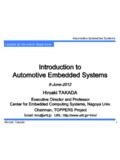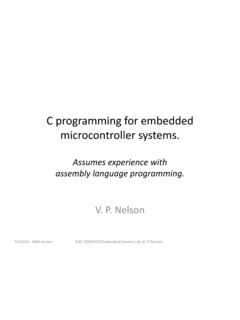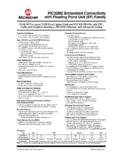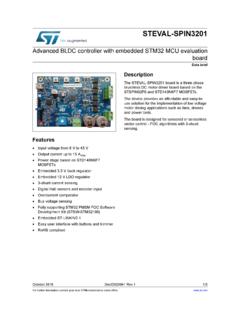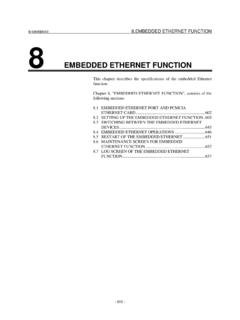Transcription of Building a Small Embedded Linux Kernel Example …
1 Application Report SPRAAH2A May 2008. Building a Small Embedded Linux Kernel Example Loc Truong and Brijesh Singh .. ABSTRACT. This application note demonstrates NOR Kernel Building and board setup using the DaVinci DM644x Digital Evaluation Module (DVEVM) package. The goal is to build the smallest possible Kernel using the MontaVista Linux Support Package (LSP) with support for an HTTP server, a TCP/IP stack, and necessary drivers for Ethernet and UART for the serial debug terminal. The Kernel resides in NOR flash and uses a RAM. disk-based file system, which is also stored on flash. This setup is found in Embedded devices such as routers and print servers, and can be used as a starting point for more sophisticated implementations such as I/O monitors, web cams, and multimedia players.
2 The application note includes the following sections: Overview of the required hardware and software available Building the Kernel Building the RAM disk file system Setting up the application Storing to flash Contents 1 Overview .. 2. 2 Feature Selection and Kernel Build Steps .. 3. 3 Building an Initial RAM Disk File System .. 6. 4 Application Support .. 8. 5 Copying Information to NOR Flash .. 10. 6 Boot Up .. 13. 7 Summary .. 14. 8 References .. 14. Appendix A .. 15. List of Figures 1 Loadable Module Support .. 4. 2 Disable File Systems .. 5. 3 Index of Mozilla Firefox .. 9. 4 EVM Boot-Up Screen .. 13. 5 Web Screen Connected to the DVEVM Web Server.
3 13. List of Tables 1 Required DVEVM Hardware Features .. 2. 2 Required DVEVM Software Packages .. 3. 3 Configuration Summary .. 3. 4 Linux Packages for the RAM Disk File System .. 7. 5 Memory Placement of Bootloader, Kernel and RAM Disk in DVEVM NOR Flash .. 12. SPRAAH2A May 2008 Building a Small Embedded Linux Kernel Example 1. Submit Documentation Feedback Overview 1 Overview To create a standalone and bootable Embedded Linux System, three main pieces of software must be flashed on the EVM: A bootloader, u-Boot in this case A Linux Kernel with built-in drivers for DaVinci DM644x devices An ARM-target Linux file system containing the shell, application and run-time support utilities and stacks This section quickly reviews the DVEVM, including required hardware and software components.
4 DM644x Digital Evaluation Module Package The DM644x EVM Kit is a collection of hardware and software packages for the Embedded Linux developer community. The hardware components include: TMS320DM6446 device-based development board NTSC/PAL video camera (region dependent). NTSC/PAL LCD display (region dependent). Microphone IR remote control 40GB, IDE hard disk drive The development board has multiple accessories and I/O interfaces such as USB, 10/100 Mbps Ethernet, video-in (composite), video-out (analog or digital), audio-in (line or microphone), audio-out ( , analog), and UART. The board also includes 4 MB of SRAM memory, 16 MB of NOR memory, 64 MB of NAND memory, a 40 GB HDD, and 256 MB of DDR2 memory.
5 For a more detailed list of all the available features of the DVEVM, consult the Technical Reference. See Table 1 for the required hardware features for this project. Table 1. Required DVEVM Hardware Features Type Device Description CPU DM6446 Dual-core multimedia processor with video acceleration hardware Non-Volatile NOR flash 16 MBytes available, 0x0200 0000 to 0x02FF FFFF. Memory Volatile Memory DDR2 256 MBytes available, 0x8000 0000 to 0x8 FFF FFFF. I/O LED 8 total, can be used for feature indication and/or user feedback Ethernet 10/100 Mbps UART0 Serial debug port, set at 115200 one stop bit, no parity, no flow control Software Components Various software components come with the DVEVM package, including multimedia demos such as audio, speech and video encode and decode using various codec formats.
6 However, in this project only the ARM Linux tool chain, the bootloader, and Linux Support Package (LSP) are needed to complete the goal of Building the smallest possible flash-based Linux Kernel with an HTTP server for the DM644x DVEVM. DevRocket is a trademark of MontaVista Software, Inc. MontaVista is a registered trademark of MontaVista Software, Inc. All other trademarks are the property of their respective owners. 2 Building a Small Embedded Linux Kernel Example SPRAAH2A May 2008. Submit Documentation Feedback Feature Selection and Kernel Build Steps Table 2 shows a list of the components that are assumed to be available for use with this project.
7 Although package versions are included in the list, later versions may be available. Table 2. Required DVEVM Software Packages Item Version Notes ARM Linux Tool Chain MVL Pro Included with DVEVM SW packages Linux Support Package MVL-401c Included with DVEVM version release Bootloader Included with DVEVM version release RAM Disk MVL Pro Included with DVEVM SW packages HTTP Web Server MVL Pro Included with DVEVM SW packages 2 Feature Selection and Kernel Build Steps Building an Embedded Linux Kernel can be complex if starting from bare silicon. Drivers must be ported or developed, tested, and compatible cross-development tool chain and upper protocol stacks updated or retargeted for the ARM926 EJS processor on the DM644x device.
8 The DVEVM package already includes most of the available tools, such as an ARM GNU tool suite, a Linux Support Package with the ARM Linux Kernel , and all the drivers needed for our project. This section assumes that you have installed the DVEVM software as described in Section 4 of the DVEVM Getting Started Guide (SPRUE66). Section 4 of the DVEVM Getting Started Guide also documents the general commands for Building a Linux Kernel . Thus, Building an Embedded Linux Kernel comprises two simple steps: Configure the Kernel to select the needed drivers and features Compile the Kernel to create an appropriate image, uImage, that u-boot can load on DVEVM. Kernel Configuration Linux Kernel features are collected in the.
9 Config file at the top level of the Kernel directory. This file is used by the GNU make utility in the build process. Although you can edit the .config file directly to turn the features on or off, several menu driven methods are available to make this step easier. The oldest one is make menuconfig, although graphical methods such as make xconfig, which uses the X-windows environment, or make gconfig, which uses GTK+ environment, are preferred. The following sections describe examples of performing the configuration using xconfig. If you are already familiar with the configuration step, use Table 3 to determine the features that must be selected or deselected from the default LSP of the DVEVM.
10 Table 3. Configuration Summary Enable Disable ARM System Type (TI-Davinci) Loadable module support TI DM644x Based system Built-in firmware loadable support TI Davinci EVM MTD support TI Davinci I2C Expander Loop back device support ARM EABI Support ATA/ATAPI support High-Resolution Timer SCSI support Networking Support Input device support Initial RAM disk Support Video for Linux support Kernel .config File Support Ext3/XFS/Minix/Automounter/MSDOS/VFAT/CR AMFS/NFS support Configure Kernel for Small Devices Frame buffer device support POSIX Message Queues USB Support System V IPC Sound card support SPRAAH2A May 2008 Building a Small Embedded Linux Kernel Example 3.










